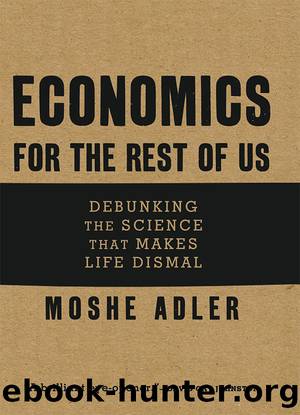Economics for the Rest of Us by Moshe Adler

Author:Moshe Adler
Language: eng
Format: epub
Publisher: The New Press
Published: 2019-06-15T00:00:00+00:00
Part II
THEORIES OF WAGES
INTRODUCTION: CLASSICAL AND NEO-CLASSICAL THEORIES OF WAGES
In 2007, U.S. workers produced $95,000 worth of goods and services per worker.1 If each of them, whether CEO or worker on the shop floor, whether in the financial industry or in agriculture, earned this wage, all families could live not only well but also in affluence. But this is, of course, not the case. Nationwide, 25 percent of workers earn wages that with full-time work put them below the poverty line.2 In New York City, 24 percent of retail workers must rely on some form of welfare payments while they are working full-time.3 What workers do not get, executives do. In 2007, average CEO compensation for S&P 500 CEOs was $10.5 million, 344 times the pay of the average worker.4
Should the government intervene to reduce wage inequality? The answer depends on what the consequences of such intervention would be, and different economists have vastly different theories about the impact. According to todayâs textbook theory of wages, first developed by neoclassical economist John Bates Clark (1847â1938), the free market ensures that each member of the workforce is naturally paid the value of what she has produced. Any interference will create an artificial level of remuneration that will result in lost jobs. Thus a worker who earns $25,000 per year produces $25,000 per year worth of goods. If the government were to pass a law forcing that workerâs employer to pay her more, it might as well print her pink slip at the same time: no employer could pay more than $25,000 for $25,000 worth of output and expect to stay in business. The same holds also for highly paid executives, but in reverse. An executive who is paid tens of millions of dollars a year in compensation produces tens of millions of dollars per year for the company. If the government were to break the link between her âcompensationâ and her productivity by placing a cap on her pay, she would choose either to work in a less demanding job or work less diligently.
Logical as the neo-classical theory of wages is, the classical economist David Ricardo (1772â1823) had dismissed it even before it was put forth. Knowing what each worker produces is usually impossible, he pointed out. And from this it follows that any system based on assessing productivity is fundamentally flawed. To take a current-day example, a taxi in a metropolitan city produces a total income of $100,000 a year, of which the driver receives $25,000 and the owner of the taxi receives the rest. Did the driver produce one-quarter of the total product of the taxi? Without the taxi (means of production in some economic theories), the driver (the worker) would have produced no fares, but without the driver the taxi would have produced no fares either. Taxi and driver together produced $100,000, but how much of the total each produced is impossible to tell. How then is the income of the taxi divided between them? Adam Smith (1723â90),
Download
This site does not store any files on its server. We only index and link to content provided by other sites. Please contact the content providers to delete copyright contents if any and email us, we'll remove relevant links or contents immediately.
International Integration of the Brazilian Economy by Elias C. Grivoyannis(91533)
The Radium Girls by Kate Moore(11927)
Turbulence by E. J. Noyes(7941)
Nudge - Improving Decisions about Health, Wealth, and Happiness by Thaler Sunstein(7622)
The Black Swan by Nassim Nicholas Taleb(7016)
Rich Dad Poor Dad by Robert T. Kiyosaki(6413)
Pioneering Portfolio Management by David F. Swensen(6229)
Man-made Catastrophes and Risk Information Concealment by Dmitry Chernov & Didier Sornette(5924)
Zero to One by Peter Thiel(5690)
Secrecy World by Jake Bernstein(4651)
Millionaire: The Philanderer, Gambler, and Duelist Who Invented Modern Finance by Janet Gleeson(4382)
The Age of Surveillance Capitalism by Shoshana Zuboff(4214)
Skin in the Game by Nassim Nicholas Taleb(4165)
Bullshit Jobs by David Graeber(4100)
The Money Culture by Michael Lewis(4082)
Skin in the Game: Hidden Asymmetries in Daily Life by Nassim Nicholas Taleb(3935)
The Dhandho Investor by Mohnish Pabrai(3705)
The Wisdom of Finance by Mihir Desai(3658)
Blockchain Basics by Daniel Drescher(3511)
